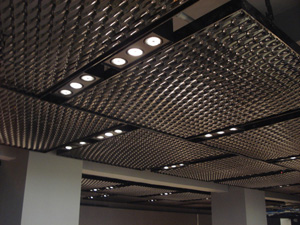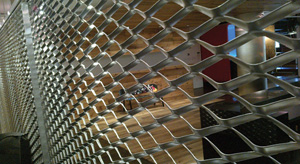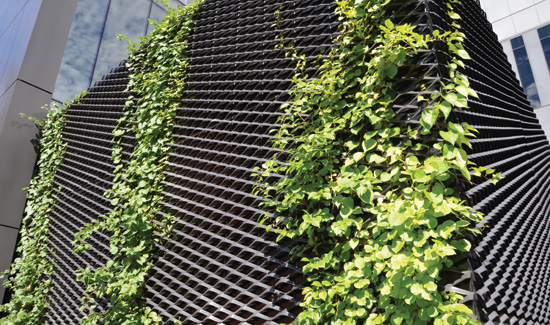Expanded Metal Mesh in Architecture
 |
The ceiling of the DDC Minotti building uses large panels of very three-dimensional expanded metal mesh to create a strong interior design statement. Photo courtesy of AMICO |
 |
An interior partition made of expanded metal mesh will provide a physical separation while still allowing light and air to penetrate. Photo courtesy of AMICO |
Building Interior Uses
Moving to building interiors, expanded metal mesh has been similarly used in a variety of ways to define or complement an overall interior design scheme. Many building interiors require the durability and longevity of metal but also seek the open and airy attributes that expanded metal mesh can bring. Some of the more common applications include the following:
- Ceilings: Either large or small decorative metal panels can be fabricated from expanded metal mesh. The pattern, shape, depth, and materials can all be varied to create the best solution for a particular interior. The structure of expanded metal aids with the disruption of sound waves thus deadening noise and reducing echoes which can be further enhanced if needed with sound absorptive material behind the mesh. From a life safety point of view, the open area of the mesh allows sprinkler systems to be located above the mesh but still work effectively without being exposed to view. The open nature of the mesh means that air also readily flows through so HVAC grilles and diffusers can similarly be located above the mesh while still serving the spaces below. Lighting systems can be incorporated into a ceiling pattern or the ceiling can be used to distribute reflected light originating below it. The net effect is a ceiling system that is uniform and consistent in appearance without the unsightly disruptions of mechanical and electrical hardware or systems.
- Partitions: Interior decorative partitions are used for visual separation of spaces, for way-finding, and for the general definition of areas at all levels. In situations where some visual connection may be desired but a separation of spaces is needed for flow, security, or other reasons, then expanded metal mesh is an enticing solution. When used as an interior partition or screening, the mesh will still allow air flow and light to pass through such that mechanical and electrical systems need not be directly impacted by its presence. Depending on the metal used and the treatment, it can in fact be a true design feature. Expanded metal partitions and enclosures provide workers and equipment with protection, permit surveillance of critical plant areas, and act as barriers for in-plant traffic flow.
- Interior balustrades: Similar to exterior stairways, interior stairways can be treated with expanded metal mesh to fill in the balustrade area and provide safety for people using the stairs. The selection of the metal and the mesh design can blend with and enhance the rest of the interior treatments in the process.
Green Building Contributions
The USGBC LEED Green Building Rating System™ is recognized as the leading nationally accepted benchmark for the design, construction, and operation of a growing family of high performance green buildings. While LEED promotes a whole-building approach to sustainability, a significant supporting component can be found in the use of materials selected for any particular building. All LEED systems currently recognize performance in the seven key areas of sustainable sites, water efficiency, energy and atmosphere, materials and resources, indoor environmental quality, innovation in design and regional priority credits. Expanded metal mesh can contribute to credits in at least three of them; energy and atmosphere, materials and resources, and indoor environmental quality.
- Energy and Atmosphere — Optimize Energy Performance: Achieve increasing levels of energy performance above the baseline in the prerequisite standard to reduce environmental and economic impacts associated with excessive energy use. By using expanded metal mesh as sun shades or as an exterior facade, solar gain into the building is reduced, in turn reducing the amount of energy required to run HVAC systems.
- Indoor Environmental Quality — Provide for the building occupants a connection between indoor spaces and the outdoors through the introduction of daylight and views into the regularly occupied areas of the building (75%-90%). Expanded metal mesh products used in applications such as facades or sunshades can help maximize day lighting opportunities while decreasing artificial lighting as well as heating and cooling costs.
- Materials and Resources — There are several relevant points under this category:
- Construction Waste Management: Divert construction and demolition debris from disposal in landfills and incinerators. Since expanded metal mesh products are produced primarily from steel and other recyclable metals, any construction waste generated can and should be included in a construction waste management plan.
- Recycled Content: Increase demand for building products that incorporate recycled content materials, thereby reducing impacts resulting from extraction and processing of virgin materials. The majority of expanded metal mesh products are produced from North America’s most recycled materials such as steel and other metals with recycled content. Therefore, recycled content can easily be specified and achieved in construction.
- Regional Materials: Increase demand for building materials and products that have been extracted, harvested or recovered, as well as manufactured, within 500 miles of the project site. Many expanded metal mesh manufacturing facilities are located across North America and many purchase raw materials from vendors in close proximity to these locations. Regional material credits may well apply in many cases as a result.
 |
Expanded metal mesh can contribute to green building design criteria and allow for some environmentally innovative design approaches as well. Photo courtesy of AMICO |









